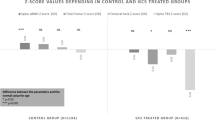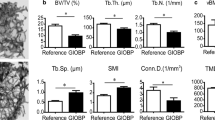Abstract
Osteoporosis is one of the major complications of glucocorticoid (GC) therapy. Few data are available on the usefulness of quantitative ultrasound (QUS), a technique that could also theoretically provide information on bone structure, in the management of glucocorticoid-induced osteoporosis (GIO). This study aimed (1) to evaluate the ability of QUS in detecting bone impairment and in being associated with the prevalence of fragility fracture in GC patients; and (2) to assess whether QUS parameters, and particularly the graphic trace analysis of QUS signal at phalanges, show any peculiar pattern of GIO. We studied 192 patients (136 women and 56 men, mean age 56.7 ± 14.2 years) on treatment with GCs for at least 6 months, and 192 sex- and age-matched controls. In all subjects, we measured bone mineral density (BMD) at lumbar spine and at femur by DXA, and ultrasound parameters at calcaneus and phalanges. All DXA and QUS parameters were significantly lower in GC patients than in controls and in fracture than in nonfracture GC patients. BMD at lumbar spine showed the best ability in discriminating GC patients with or without fractures. Among QUS parameters, stiffness showed a discriminatory ability significantly better than AD-SoS. BMD at lumbar spine and total femur, stiffness, and AD-SoS are able to predict the odds of fragility fracture event. QUS parameters of the postmenopausal GC patients (n=105) and of the postmenopausal healthy controls (n=101) were also compared with those obtained in a separate sample of 90 postmenopausal osteoporotic women (PMO). All parameters were significantly lower in GC patients and in PMO than in controls, without any significant difference between GC and PMO. Our findings show that QUS can be useful in the assessment of glucocorticoid-induced bone impairment. In addition, in this study we found no alteration in QUS parameters or in the graphic trace analysis which could differentiate between GIO and PMO. Further longitudinal studies are needed to define the role of QUS in the prediction of fracture risk and in the clinical management of GIO.
Similar content being viewed by others
References
Reid IR (1998) Glucocorticoid effects on bone. J Clin Endocrinol Metab 83:1860–1862
van Staa TP, Leufkens H, Abenhaim L, Zang B, Cooper C (2000) Use of oral corticosteroids and risk of fractures. J Bone Miner Res 15:993–1000
Reid IR (1997) Glucocorticoid osteoporosis: mechanism and management. Eur J Endocrinol 137:209–217
Sinigaglia L, Nervetti A, Mela Q, Bianchi G, Del Puente A, Di Munno O, Frediani B, Cantatore F, Pellerito R, Bartolone S, La Montagna G, Adami S (2000) A multicenter cross sectional study on bone mineral density in rheumatoid arthritis. Italian Study Group on Bone Mass in Rheumatoid Arthritis. J Rheumatol 27:2582–2589
Luengo M, Picado C, Del Rio L, Guanabens N, Montserrat JM, Setoain J (1991) Vertebral fracture in steroid dependent asthma and involutional osteoporosis: a comparative study. Thorax 46:803–806
Clowes JA, Peel N, Eastell R (2001) Glucocorticoid induced osteoporosis. Curr Opin Rheumatol 13:326–332
Aaron JE, Francis RM, Peacock M, Makins NB (1989) Contrasting microanatomy of idiopathic and corticosteroid-induced osteoporosis. Curr Opin Rheumatol 243:294–305
Dalle Carbonare L, Arlot ME, Chavassieux PM, Roux JP, Portero NR, Meunier PJ (2001) Comparison of trabecular bone architecture and remodelling in glucocorticoid-induced and postmenopausal osteoporosis. J Bone Miner Res 16:97–103
Gluer CC for the International Quantitative Ultrasound Consensus Group (1997) Quantitative ultrasound techniques for the assessment of osteoporosis: expert agreement on current status. J Bone Miner Res 12:1280–1288
Njeh CF, Fuerst T, Diessel E, Genant HK (2001) Is quantitative ultrasound dependent on bone structure? A reflection. Osteoporos Int 12:1–15
Hans D, Dargent-Molina P, Schott AM et al for the EPIDOS Prospective Study Group (1996) Ultrasonographic heel measurements to predict hip fracture in elderly women: the EPIDOS prospective study. Lancet 348:511–514
Montagnani A, Gonnelli S, Cepollaro C et al (2002) Graphic trace analysis of quantitative ultrasound at phalanxes seems to improve the diagnosis of primary hyperparathyroidism among patients with low bone mass. Osteoporos Int 13:222–227
Kos-Kudla B, Pluskiewicz W (1997) Quantitative ultrasound of the heel and serum and urinary cortisol values in assessment of long-term corticotherapy side effects in female bronchial asthma patients. Ultrasound Med Biol 23:1325–1330
Blanckaert F, Cortet B, Coquerelle P et al (1997) Contribution of calcaneal ultrasonic assessment to the evaluation of postmenopausal and glucocorticoid-induced osteoporosis. Rev Rheum 64:305–313
Fries W, Dinca M, Luisetto G, Peccolo F, Bottega F, Martin A (1998) Calcaneal ultrasound bone densitometry in inflammatory bowel disease: a comparison with double X-ray densitometry of lumbar spine. Am J Gastroenterol 93:2339–2344
Daens S, Peretz A, de Maertelaer V, Moris M, Bergmann P (1999) Efficiency of quantitative ultrasound measurements as compared with dual X-ray absorptiometry in the assessment of corticosteroid-induced bone impairment. Osteoporos Int 10:278–283
Sambrook P, Raj A, Hunter D, Naganathan V, Mason R, Robinson B (2001) Osteoporosis with low dose corticosteroids: contribution of underlying disease effects and discriminatory ability of ultrasound versus bone densitometry. J Rheumatol 28:1063–1067
Cortet B, Cortet C, Blanckaert F et al (2001) Quantitative ultrasound of bone and markers of bone turnover in Cushing’s Syndrome. Osteoporos Int 12:117–123
Tauchmanova L, Rossi R, Nuzzo V et al (2001) Bone loss determined by quantitative ultrasonometry correlates inversely with disease activity in patients with endogenous glucocorticoid excess due to adrenal mass. Eur J Endocrinol 145:241–247
Javaid MK, McCrudden PR, Taylor P et al (2001) Comparison of calcaneal ultrasound and DXA to assess the risk of corticosteroid-induced osteoporosis: a cross-sectional study. Osteoporos Int 12:788–793
Lernbass I, Wutzl A, Grisar J et al (2002) Quantitative ultrasound in the assessment of bone status of patients suffering from rheumatic diseases. Skeletal Radiol 31:270–276
Flohr F, Lutz A, App AE, Matthys H, Reincke M (2002) Bone mineral density and quantitative ultrasound in adults with cystic fibrosis. Eur J Endocrinol 146:531–536
Barkmann R, Lusse S, Stampa B, Sakata S, Heller M, Gluer CC (2000) Assessment of the geometry of human finger phalanges using quantitative ultrasound in vivo. Osteoporos Int 11:745–755
Wuster C, Albanese C, De Aloysio D et al and the Phalangeal Osteosonogrammetry Study Group (2000) Phalangeal osteosonogrammometry study: age-related changes, diagnostic sensitivity, and discrimination power. J Bone Miner Res 15:1603–1614
Hanley JA, McNeil BJ (1983) A method of comparing the areas under receiver operating characteristic curves derived from the same cases. Radiology 148:839–843
Peel NF, Moore DJ, Barrington NA et al (1995) Risk of vertebral fracture and relationship to bone mineral density in steroid treated rheumatoid arthritis. Ann Rheum Dis 54:801–806
Van Staa TP, Leufkens HGM, Cooper C (2002) The epidemiology of corticosteroid-induced osteoporosis: a meta-analysis. Osteoporos Int 13:777–787
Rubin M, Bilezikian J (2002) The role of parathyroid hormone in the pathogenesis of glucocorticoid induced osteoporosis: a re-examination of the evidence. J Clin Endocrinol Metab 87:4033–4041
Author information
Authors and Affiliations
Corresponding author
Rights and permissions
About this article
Cite this article
Cepollaro, C., Gonnelli, S., Rottoli, P. et al. Bone ultrasonography in glucocorticoid-induced osteoporosis. Osteoporos Int 16, 743–748 (2005). https://doi.org/10.1007/s00198-004-1741-z
Received:
Accepted:
Published:
Issue Date:
DOI: https://doi.org/10.1007/s00198-004-1741-z




